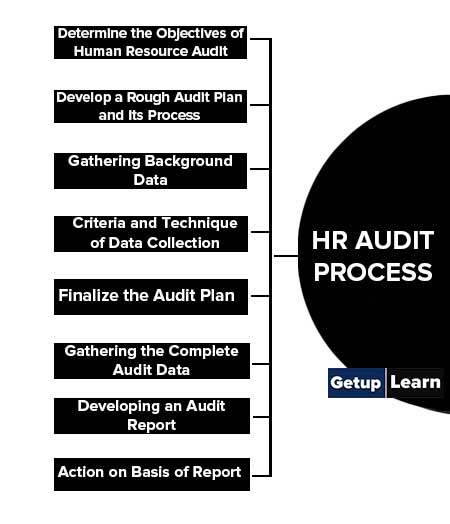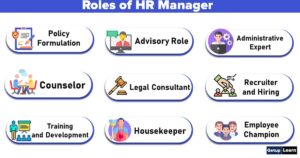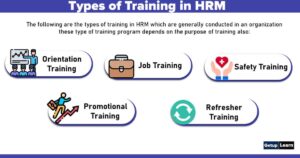Table of Contents
- 1 What is Human Resource Auditing?
- 2 Meaning of Human Resource Audit
- 3 Definition of Human Resource Audit
- 4 Features of Human Resource Audit
- 5 Objectives of Human Resource Audit
- 6 Scope of Human Resource Audit
-
7 HR Audit Process
- 7.1 Determine the Objectives of Human Resource Audit
- 7.2 Develop a Rough Audit Plan and Its Process
- 7.3 Gathering Background Data
- 7.4 Determine the Criteria and Technique of Data Collection
- 7.5 Finalize the Audit Plan
- 7.6 Gathering the Complete Audit Data
- 7.7 Developing an Audit Report
- 7.8 Action on Basis of Report
- 8 Effective Human Resource Audit
- 9 FAQ Related to Human Resource Audit
What is Human Resource Auditing?
A Human Resource audit is defined as an investigation into size, skill, structure and all other issues surrounding those currently employed by the organisation and its future Human Resources needs.

Meaning of Human Resource Audit
Human resources or HRD audit is a systematic survey and analysis of different HRD functions with a summarized statement of findings and recommendations for correction of deficiencies.
It examines and evaluates policies, procedures and practices to determine the effectiveness of HRD function in an organization. HRD audit ensures that sound and cost-effective policies are implemented.
Human resource audit refers to the checking of the performance of the enterprise in its management of human resources. A human resource audit reveals how the management is doing in getting things done through the efforts of its people. It undertakes systematic research on the effectiveness of the human resource programme.
It evaluates the personnel activities of an organization. It acts as overall quality control, and checks on human resource function. During the conduct of the audit, if any deficiency is discovered, steps are taken to remove it. It reviews the effectiveness of management relating to the:
- Measurement of the effectiveness of human resource programmes and activities.
- The determination of what should or should not be done in the future as a result of such measurement.
A human resource audit is one, which checks the performance of its enterprise as to the management of its human resources. Its aim is to determine how effectively the human resource programme has been implemented.
It measures the performance of human resource functions, compares with the standard and discovers the variance and takes corrective action to remove them also. In short, it acts as a control mechanism as far as human resource function is concerned.
Definition of Human Resource Audit
The Following are the definitions of human resource audit:
[su_quote cite=”Jack J. Philips”]A Human Resource audit is defined as an investigative, analytical and comparative process that attempts to reflect the effectiveness of Human Resources functions.[/su_quote]
[su_quote cite=”David Campbell”]He defined it as follows, “Human Resource audit is defined as an investigation into size, skill, structure and all other issues surrounding those currently employed by the organisation and its future Human Resources needs.[/su_quote]
[su_quote cite=”Eric G. Flamholtz”]Human Resource audit is a systematic assessment of the strengths, limitations and developmental needs of its exist- ing human resources in the context of organisational performance.[/su_quote]
[su_quote cite=”Rosemary Harrison”]Human Resource audit is defined as a way of assessing the nature and impact of human resource department activity at particular points in time.[/su_quote]
Features of Human Resource Audit
The primary goal of the human resource audit is to assess how efficiently human resource functions are performed by the Human Resources department. The other features of human resource audit are:
- A Human Resource audit is an independent, objective and critical ex- amination of the human resource functions of an organisation.
- It gathers data about the people, processes, structure and policies of an organisation. (3)It establishes a benchmark for measuring the actual performance of the Human Resources department to identify the performance and efficiency gaps.
- It also detects if the Human Resources department on matters where it does not comply with the statutory provisions, corporate goals and Human Resources policies.
- A human Resource audit is done by internal employees or external consultants with basic knowledge of law and auditing.
- A human Resource audit should be carried out at regular intervals generally once a year.
Objectives of Human Resource Audit
A Human Resource Audit is undertaken to evaluate the human resource policies, procedures and practices of an organisation to determine the extent of its contribution to accomplishing corporate objectives. The following are the other objectives of the Human Resource audit:
- It helps in identifying the degree of efficiency in the performance of the Human Resources department in implementing human resource policies and practices of the organisation and assesses the general environment in the Human Resources department.
- To propose appropriate strategies and corrective action, in case of performance and efficiency gaps.
- Determine whether Human Resources functions are performed as per established practices and procedures of the organisation.
- To measure the Human Resources department’s record of compliance with statutory provisions regarding hiring, compensation, safety and health, dispute settlement etc.
- Discover the areas where cost can be reduced in Human Resources activities such as recruitment, development, retention and separation of human resources.
- For having improved control over and checking all internal operations of the organisation.
- To create a sense of accountability and discipline among employees by investigating past actions periodically.
- Determine human resource areas and functions which need further research and development.
- Recognise good work done by people and reward them in an appropriate manner.
- Prepare the organisation to address the legal actions which may be initiated by employees in an effective manner.
Scope of Human Resource Audit
Scope of Human Resource audit is normally confined to activities which are connected with the Human Resources department of the organisation. The following are activities which are covered within the scope of Human Resource audit:
- All application forms including recruitment forms, internal communication and promotion forms.
-
Job description and job specification statements.
- Files and records which are related to any aspect of Human Resources.
- Hiring policies and practices.
- Compensation policies and practices.
- Training and orientation policies, practices and programs.
- Separation schemes and practices.
- Records relating to legal reporting and compliance.
- Records relating to promotion and transfers.
- Grievance resolution and disciplinary action procedures and records.
- Policies and procedures relating to safety and health.
- Details of welfare activities undertaken.
- Information about workers’ participation in management.
- Details about exit and other interviews.
- Reports related to accidents, labour turnover, absenteeism and leaves.
- Industrial relation policies and practices.
- Information related to harassment and discrimination.
- Information about regulatory compliance.
HR Audit Process
A Human Resource audit is viewed as a creative and capable instrument for engaging human resources in an effective manner. But it is not a statutory requirement and each organisation can have their own system for conducting Human Resource auditing and it depends on its size, objectives, situations and end-users.
The following are the steps which are involved in a typical HR audit process:
- Determine the Objectives of Human Resource Audit
- Develop a Rough Audit Plan and Its Process
- Gathering Background Data
- Determine the Criteria and Technique of Data Collection
- Finalize the Audit Plan
- Gathering the Complete Audit Data
- Developing an Audit Report
- Action on Basis of Report

Determine the Objectives of Human Resource Audit
The first step of the Human Resource audit is to make a decision regarding the objectives of Human Resource audit. It attempts to know the efficacy of human resource policies, procedures, regulatory compliance by the human resource department or the degree of alignment between corporate strategy and Human Resource strategy.
It might also attempt to identify and solve specific problems such as high industrial disputes, labour turnover and absenteeism. When objectives are clearly defined, the auditor could remain focused on the task which is assigned to them. When an external auditor is appointed, a term of the contract should be set in writing. On the other hand, when an internal person is assigned this work, it should be ensured that the person has high integrity and objectivity.
Develop a Rough Audit Plan and Its Process
Once a human resource auditor is appointed, he should prepare a rough sketch of the entire process and how he should proceed by focusing on the areas identified by him. A rough draft would allow the auditor to foresee the likely hurdles in the audit process.
It also helps in forecasting the men, money and material required for the entire audit which have to be tapped for gathering relevant information.
Gathering Background Data
In this stage, the auditor gathers information about the external and internal factors. For this, the auditor may collect information on the competitive positions of the organisation, industrial overview and regulatory environment of the organisation.
He might also collect information about the competitive strategy of the organisation, labour market conditions and shifts, the intensity of competition, long term threats and opportunities for the industry, the environmental constraints, political, social, and cultural factors and their impact on staffing and other human resource functions.
For assessing the internal environment, the auditor may collect information about corporate strategy, mission and vision, human resource policies and procedures. Information from various stakeholders may also be collected by the auditor. All this information is collected to assess the general internal and external environment of the organisation. After this, the rough draft of the audit process and the objectives may be reviewed by him.
Determine the Criteria and Technique of Data Collection
On the basis of the data collected, the auditor finalizes the nature of the data to be collected and the time and duration of such collection. He would then decide the criteria for evaluating the data. During this time, the organisation also finalizes the instruments of data collection which include interview schedule, questionnaire, document review, focus groups and observations.
Finalize the Audit Plan
On the basis of the background information and experience gathered, the auditor may make necessary changes in the rough draft of the audit plan. Then the auditor may finalise the audit plan.
The final audit plan should have clarity about the audit objectives, time frame for auditing, target departments and people, type of data needed and data collection tools and the cost of the intended exercise. Once the audit plan is finalised, the human resource auditor can start the data collection process.
Gathering the Complete Audit Data
By taking into consideration the audit objectives and plan, the auditor should compile all the relevant information. He may have to interview the senior management to collect the relevant information. For this, he may employ questionnaires and interviews to assemble the necessary data.
For collecting the data, the auditor may examine personnel files, internal memos, employee handbooks and other documents. If the audit is undertaken for any specific purpose, then the documents related to such activity should also be considered by the auditor.
After all relevant information about various aspects of human resources is collected, the collected information is analysed using the final audit plan to identify the strengths and weaknesses of the current system.
Developing an Audit Report
Once the review of relevant information is completed, the auditor has to develop a comprehensive audit report. It usually covers all areas of human resource operations such as hiring, training, compensation, performance evaluation and industrial relations.
They may also consider factors such as regulatory environment, global human resources strategy, strategic human resource and management, job designs, internal and external relations, communication styles etc. It is desirable that the auditor employs the SWOT (Strengths, Weaknesses, Opportunities and Threats) technique for the analysis and presentation of information for a better understanding of facts and figures.
Action on Basis of Report
Once the audit report is prepared, the entire purpose of undertaking an audit would be fulfilled when an action is taken on its basis. The response of the organisation would depend on the recommendations given in that report.
It might be possible that on the basis of the recommendations, the human resource policies and practices may have to be revised and priorities may have to be reset or corporate strategies may have to be realigned.
Effective Human Resource Audit
The following are the conditions which should be satisfied for making it effective:
- In order to undertake a Human Resource audit, it is essential that the top management supports such an audit otherwise the employees would lose confidence in the process of the Human Resource audit is conducted.
- As the audit practices are guided by the objectives of the Human Resource audit, the organisation should decide in advance if the audit program should be comprehensive or have a specific objective. This ensures that the audit process is smooth and effortless.
- Any person who is appointed as an auditor should have high integrity, value and knowledge in the case of internal auditors. Their recommendations should be objective and impartial in nature to have full acceptance among the employees.
- Employees should know in advance what is to be performed as part of their job and how it is to be performed. An effective audit requires clarity in the authority, responsibility and accountability of employees.
- Management should ensure that there is an effective flow of information at all levels of the organisation so that employees know what is required to be performed.
- The Human Resource audit results should be shared with the employees so that they know their strengths and weaknesses. It would facilitate the employees in building on their strengths and working on their weaknesses.
- A human Resource audit should not be viewed as a one-time activity and must be done on a regular basis with prior information to the employees.
What is a simple definition of human resource audit?
A Human Resource audit is defined as an investigative, analytical and comparative process that attempts to reflect the effectiveness of Human Resources functions. By Jack J. Philips
What are the steps in HR auditing process?
The following are the steps which are involved in a typical HR audit process:
1. Determine the Objectives of Human Resource Audit
2. Develop a Rough Audit Plan and Its Process
3. Gathering Background Data
4. Determine the Criteria and Technique of Data Collection
5. Finalize the Audit Plan
6. Gathering the Complete Audit Data
7. Developing an Audit Report
8. Action on Basis of Report etc.


















